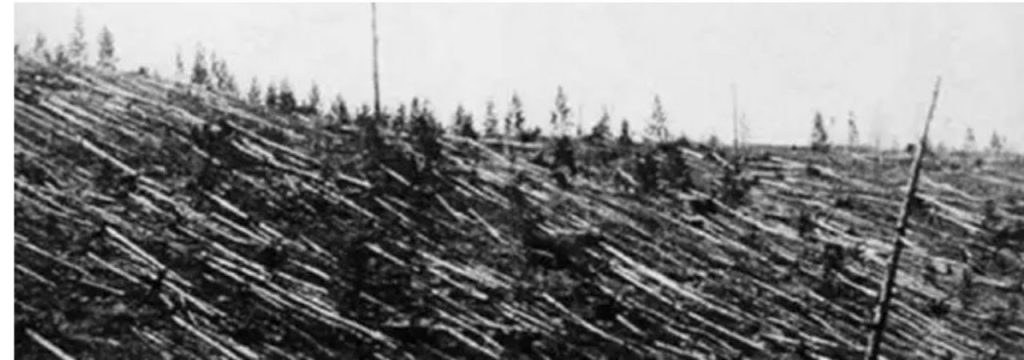
The mysterious blast that occurred over the Siberian wilderness in 1908 has been the subject of considerable scientific discussion and debate. [A] On the morning of June 30, 1908, a brilliant bluish-white fireball streaked across the sky over Siberia. [B] While still in the air, it exploded in a blinding flash of light. [C] The blast was heard 1,000 kilometers away, and a glowing reddish haze was observed high in the atmosphere for several nights following the event. [D]
Because travel was difficult in the Siberian wilderness, no one is known to have traveled to the site of the explosion until 19 years after the explosion occurred. When an expedition finally went in search of the site of the blast, it found that the blast had occurred in the sky above the stony Tunguska River valley. Branches and leaves had been stripped away from the tree trunks in the area, and the remaining trees had been flattened radially away from the center of the blast for 20 kilometers in each direction. There were branchless trunks of the trees at the center of the blast area, and no discernible crater was in evidence; on the basis of these facts, it was concluded that a huge explosion must have taken place at least a few kilometers above the blast area rather than as a result of an impact between an object and the Earth. However, it was not immediately apparent what could have caused the powerful explosion.
The event at Tunguska was so unusual that a number of bizarre hypotheses have been proposed to explain it. One hypothesis was that an alien spaceship was attempting to land because of a malfunctioning nuclear reactor, and the nuclear reactor exploded and destroyed all evidence of the spacecraft. Another hypothesis was that a tiny black hole had entered the Earth's atmosphere above Tunguska, creating the damage there, and then had exited the atmosphere over the northern part of the Pacific Ocean without being noticed. A third hypothesis was that a piece of antimatter had entered the Earth's atmosphere and then exploded when it came into contact with matter in the atmosphere.
[A] What many astronomers now suspect is that the head of a small comet or a fragment of a comet exploded into pieces in the layers of the atmosphere above the Earth. [B] Though there are some who oppose this view, it is now widely accepted as one of the more reasonable hypotheses. [C] According to this explanation, a comet or comet fragment was heading for the Earth but was not seen because it was coming from the direction of the sun. [D] Eyewitnesses to the event had reported that a fireball was visible in the sky coming from the east prior to the blast. A characteristic tail was not seen following the comet, but this could have been either because the tail was hidden behind the comet due to the direction that the comet was traveling, because the comet was actually the exhausted core of a comet with little or no tail, or because it was a fragment of a comet without a tail. Something that further establishes the validity of the hypothesis that the blast at Tunguska was caused by a fragment of a comet or the head of a small comet is the thousands of tons of powdered material resembling carbonaceous chondrites scattered around the area of the blast; a fragment of a partially exhausted comet would most likely consist of such material mixed with ice.





